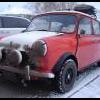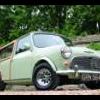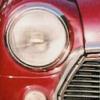The adjustable ones (and I would guess any that you make yourself) require very detailed and careful setting up of the suspension. These are all designed to work with the normal rubber cones so how the fitting of coil springs would effect them is something to consider.
The rear ones are fitted to two nylon or metal (better than nylon) blocks mounted across the bottom of the subframe rear lateral member and the drop links are fitted to brackets fitted to the rear of two of the three brake backplate mounting screws, so that the radius arm is clamped between the back plate and the bracket. Obviously the effect of the torsion bar depends on how far along the arms of the bar the drop links are mounted. The new bars have plates welded to the ends of the bars instead of being bent from a single bar stock. This makes them lighter and more compact so they don't foul stuff under the car. It also means the mounting blocks can be closer to the arms as there's no bend in the bar to contend with. Road spec bars are 1/2" and race spec are 3/4". The plates on the ends are 4mm plate I think, with holes drilled in them at intervals for adjusting the amount of torsion.
The front ones also mount to a pair of blocks across the bottom of the subframe and the torsion arms are formed to run along inboard of the tie rod (single bent torsion bar this time), which they are clamped to directly in the case of the fixed bar. The adjustable one is fitted via drop links to the lower shock mountings. The bar sizes are the same as the rear versions.
Now I've never actually got around to driving a car with one fitted but I've been over the concept a lot and I'm trying to get one together before the trip to the ring. I have been told conflicting stories about how much use the rear bar is, some say fit a front bar only and others say use both together. I do know that at least one will help tremendously with handling as a whole, giving even more cornering ability and predictability.
Edited by Dan, 30 June 2006 - 11:39 PM.


















